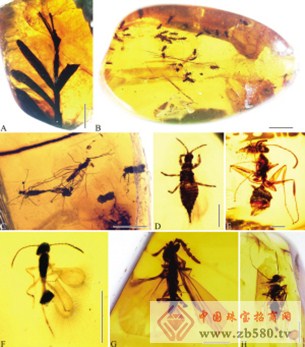The crystal clear amber is a gem in the eyes of ordinary people. In the eyes of experts, it is a treasure that records the mystery of the ancient life of the earth. Yesterday, the Nanjing Institute of Geology and Paleontology of the Chinese Academy of Sciences announced that the research team led by the researcher Zhang Haichun determined that Fushun Amber is one of the most abundant amber biota in the world. This study not only fills in the gaps in the amber biota of the Asian continent during the Eocene (about 50 million years ago), but also shows that there has been extensive biological exchanges at both ends of the Eurasia 50 million years ago.

Found 2000 gems amber
"In the transparent amber, the flies and the spiders are still lying well. We can see every vellus on them. I can imagine how they struggled in the viscous gluten because of their legs. There are several rings of black rings around. From that amber, we can speculate on the details of the story that occurred 10,000 years ago, and we know that in ancient times, there were already flies and spiders in the world." Excerpted from the sixth grade language text "Amber".
Amber is a resin of 100 million years ago, which was secreted by coniferous trees. It is a natural resin fossil that has evolved from the earth's crust movement and is known as "the lightest gem in the world". Amber, which is wrapped in ancient insects like the text, is a treasure in the gem. Around the world, the abalone in Russia, Poland, Lithuania and other countries around the Baltic Sea is the most famous. In China, Liaoning Fushun amber, which was discovered more than 100 years ago, is the only known amber containing insects in China. The reputation is not too big, and there have been few studies in the past.
Zhang Haichun, a researcher at the Nanjing Institute of Geology and Paleontology, Chinese Academy of Sciences, has a strong interest in Fushun Amber. As early as 20 years ago, his research team collected field and collected amber in Fushun, Liaoning Province. So far, more than 2,000 pieces have been collected. Insects or plants, sporopollen amber. He proudly told reporters: "Amber is a beautiful gem in the eyes of ordinary people, but in our eyes it is a password to record the appearance of ancient creatures. Fine stones can talk and sing."
Sincerely to the stone "opening"
Researchers Zhang Haichun and the Institute’s Associate Professor Wang Bo and other seven Chinese experts, as well as scientists from various disciplines in Germany, the United States, Britain and France, have formed a joint team for many years of systematic research on these more than 2,000 ambers. Arthropods have at least 22 orders, more than 80 families and 150 species; of which there are more than 100 new species, of which insects are the most abundant, including at least 16 orders, 79 families, and hundreds of species. There are many like bees, ants, locusts, etc.
In these Fushun ambers, the insects are perfectly preserved, and some of the tentacles are preserved. Wang Bo pointed to a piece of amber and explained, "You see, this is nearly 30 locusts gathered together, this is a chironomid, they are It’s very rare to be preserved at the end of the season. Another example is a small bee whose wings can shine like the sun, in addition to spiders, hummers, baboons, etc.†In addition to knowing 50 million years ago The insects look like experts, and experts can also study the co-evolution process accompanying these insects and viruses.
Parasitic insects appear amber
Among all the amber, the most rare one is the winged fossil. It has a head of only about 2 mm. It is a very inconspicuous bug with a strange tentacles. It is considered to be the most mysterious insect in the world. Paleontology Experts have not figured out how to classify it so far. Wang Bo said that the surrounding countries of the Baltic Sea produce 10,000 fossils per year, but until now, only 10 pieces of the pteridophyte fossils have been found in the world, and this time, one piece was found in the 2000 fossils of Fushun, Liaoning, indicating that it is 5000. Tens of thousands of years ago, the insect species in this area were very diverse and very diverse.
Liaoning climate used to be like Fujian
Associate Professor Wang Bo told reporters that after research, these 2000 pieces of Liaoning Fushun amber came out of the early Eocene strata of 50 million years ago. At that time, Liaoning Fushun was not as cold as it is now, and it is in a greenhouse effect period. The average temperature is between 15 °C and 20 °C, and the annual precipitation is above 1000 mm. The climate is similar to the current Fujian and eastern Zhejiang.
In the ancient Fushun original forest, there are pieces of pine and cypress plants, and an aquatic environment in which a large number of ancient insects and microbes live.
And at that time, the location of Fushun was extremely critical. "We also found that social and ectoparasites such as ants and bees in Fushun amber have great similarities with the Baltic biota, indicating that there has been extensive biological communication at both ends of Eurasia 50 million years ago. This provides a direct basis for us to understand the European-Asia-India bio-distribution pattern at the time." Zhang Haichun said that this provided direct evidence for experts to understand the European-Asia-India-North American biodistribution pattern. These findings also provide important clues for studying the effects of climate change (such as the greenhouse effect) and Earth plate tectonic events (such as the uplift of the Qinghai-Tibet Plateau) on the evolution of Eurasia.
Woven Fabric,Viscose Crepe Fabric,Bubble Fabric,100% Printed Viscose Fabric
Shaoxing Xiaotrain Imp.&Exp Co., Ltd , https://www.xiaotrain.com